What regulations and requirements must be followed after obtaining EU CE certification for Class D medical devices?
Release time:2024-08-19 14:18:13
The author:
source:
Ongoing Monitoring: Continuously monitor the performance and safety of your device once it is on the market.
After obtaining EU CE certification for Class D medical devices, several regulations and requirements must be followed to maintain compliance and ensure the continued safety and effectiveness of your device. Here’s a summary of the key post-certification obligations:
1. Post-Market Surveillance
- Ongoing Monitoring: Continuously monitor the performance and safety of your device once it is on the market.
- Collect Feedback: Gather and analyze user feedback, adverse events, and any other relevant data.
- Update Documentation: Regularly update your post-market surveillance documentation based on the collected data.
2. Adverse Event Reporting
- Report Incidents: Notify the relevant Competent Authorities and your Notified Body of any serious adverse events or device defects.
- Implement Corrective Actions: Take appropriate corrective and preventive actions to address any issues and prevent recurrence.
3. Quality Management System (QMS)
- Maintain Compliance: Ensure ongoing compliance with ISO 13485 or an equivalent standard.
- Conduct Internal Audits: Perform regular internal audits to assess the effectiveness of your QMS.
- Management Review: Conduct periodic management reviews of your QMS to ensure it remains effective and compliant.
4. Post-Market Clinical Follow-Up (PMCF)
- Implement PMCF Plan: Execute and update your PMCF plan to gather further clinical data on the device’s performance.
- Review and Revise: Adjust the PMCF plan based on the results and any emerging data.
5. Technical Documentation Updates
- Revise Documents: Update your technical documentation to reflect any changes in the device, manufacturing processes, or regulatory requirements.
- Document Changes: Maintain records of all changes and ensure documentation is readily accessible for audits.
6. Notified Body Communication
- Notify of Changes: Inform your Notified Body of any significant changes to the device, manufacturing processes, or QMS.
- Re-certification: Be prepared for periodic re-certification audits or assessments by the Notified Body.
7. Device Labeling and Instructions for Use (IFU)
- Update Labels: Ensure that device labeling remains accurate and complies with regulatory requirements.
- Revise IFU: Update the Instructions for Use as needed based on new information or changes in the device.
8. Regulatory Changes
- Monitor Regulations: Stay informed about any changes or updates to EU regulations and standards that may affect your device.
- Adapt as Necessary: Make necessary adjustments to your processes, documentation, and practices to comply with new regulations.
9. Market Access and Distribution
- Verify Compliance: Ensure that all distributors and partners comply with regulatory requirements.
- Document Verification: Check that the CE mark is correctly affixed to the device and that all required documentation accompanies the device.
10. Training and Education
- Staff Training: Provide ongoing training for your team on regulatory requirements, quality management, and device handling.
- User Training: Ensure that healthcare providers and users are trained on the safe and effective use of the device.
11. Record Keeping
- Maintain Records: Keep comprehensive records of all activities related to post-market surveillance, adverse event reporting, and quality management.
Audit Preparation: Ensure records are organized and accessible for potential audits and inspections.

Contact Us:
Whatsapp or Wechat:+86 15816864648;email address:hito.lin@grzan.cn
.png)
.jpg)
.png)

.png)